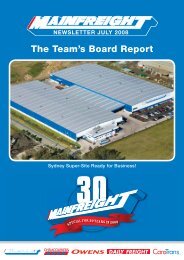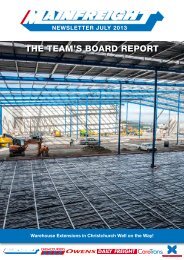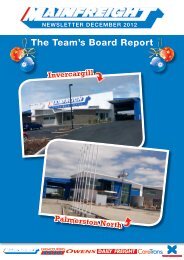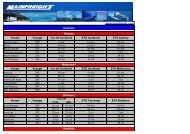Annual Report 2013 - Mainfreight
Annual Report 2013 - Mainfreight
Annual Report 2013 - Mainfreight
You also want an ePaper? Increase the reach of your titles
YUMPU automatically turns print PDFs into web optimized ePapers that Google loves.
2 Summary of Significant Accounting Policies (continued)<br />
(j)<br />
Investments in Associates<br />
The Group’s investment in its associates is accounted for using the equity method of accounting in the consolidated financial statements<br />
and at cost in the Parent. The associates are entities over which the Group has significant influence and that are neither subsidiaries<br />
nor joint ventures. The Group generally deems it has significant influence if they have over 20% of the voting rights.<br />
Under the equity method, investments in the associates are carried in the consolidated balance sheet at cost plus post-acquisition<br />
changes in the Group’s share of net assets of the associates. Goodwill relating to an associate is included in the carrying amount of the<br />
investment and is not amortised. After application of the equity method, the Group determines whether it is necessary to recognise any<br />
impairment loss with respect to the Group’s net investment in associates.<br />
The Group’s share of its associates’ post-acquisition profits or losses is recognised in the income statement, and its share of postacquisition<br />
movements in reserves is recognised in reserves. The cumulative post-acquisition movements are adjusted against the<br />
carrying amount of the investment. Dividends receivable from associates are recognised in the Parent’s income statement, while in the<br />
consolidated financial statements they reduce the carrying amount of the investment.<br />
When the Group’s share of losses in an associate equals or exceeds its interest in the associate, including any unsecured long-term<br />
receivables and loans, the Group does not recognise further losses, unless it has incurred obligations or made payments on behalf of<br />
the associate.<br />
The reporting dates of the associates and the Group are identical and the associates’ accounting policies conform to those used by the<br />
Group for like transactions and events in similar circumstances.<br />
(k) Property, Plant and Equipment<br />
Property, plant and equipment, except land, is stated at historical cost less accumulated depreciation and any accumulated impairment<br />
losses. Such cost includes the cost of replacing parts that are eligible for capitalisation when the cost of replacing the parts is incurred.<br />
All other repairs and maintenance are recognised in profit or loss as incurred.<br />
Land is measured at fair value, based on annual valuations by external independent valuers who apply the International Valuation<br />
Standards Committee International Valuation Standards, less any impairment losses recognised after the date of the revaluation.<br />
Depreciation is calculated on a straight-line basis at rates calculated to allocate the assets’ cost, less estimated residual value, over their<br />
estimated useful lives as follows:<br />
Per annum<br />
Land<br />
not depreciated<br />
Buildings 2% to 3%<br />
Leasehold Improvements 10% or life of lease if shorter<br />
Furniture & Fittings 10% to 20%<br />
Motor Cars 26% to 31%<br />
Plant and Equipment 10% to 25%<br />
Computer Hardware 28% to 36%<br />
The assets’ residual values, useful lives and depreciation methods are reviewed, and adjusted if appropriate, at each financial year end.<br />
Revaluations of Land<br />
Revaluations increment is credited to other comprehensive income and accumulated in the asset revaluation reserve except to the<br />
extent that it reverses a revaluation decrease of the same asset previously recognised in profit or loss, in which case the increase is<br />
recognised in profit or loss.<br />
Any revaluation decrement is recognised in profit or loss, except to the extent that it offsets a previous revaluation increase for the<br />
same asset, in which case the decrease is debited directly to other comprehensive income to the extent of the credit balance existing<br />
in the revaluation reserve for that asset.<br />
Upon disposal or de-recognition, any revaluation reserve relating to the particular asset being sold is transferred to retained earnings.<br />
Disposal<br />
An item of property, plant and equipment is derecognised upon disposal or when no further future economic benefits are expected from<br />
its use or disposal.<br />
Any gain or loss arising on de-recognition of the asset (calculated as the difference between the net disposal proceeds and the<br />
carrying amount of the asset) is included in profit or loss in the year the asset is derecognised.<br />
76 <strong>Mainfreight</strong> | <strong>Annual</strong> <strong>Report</strong> <strong>2013</strong>
















